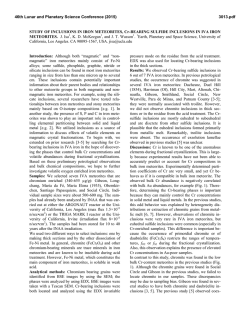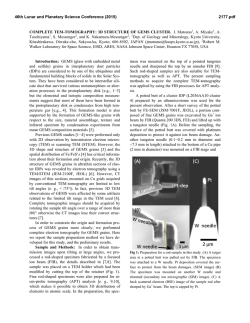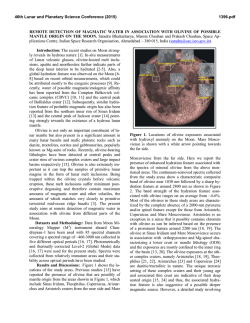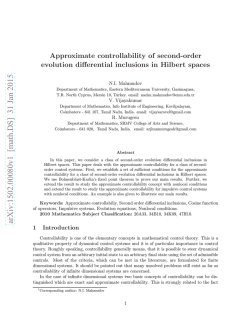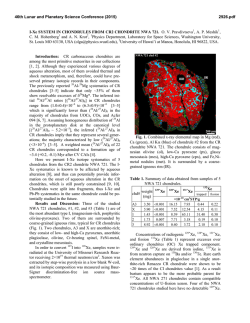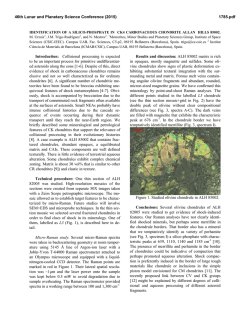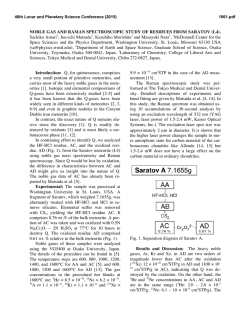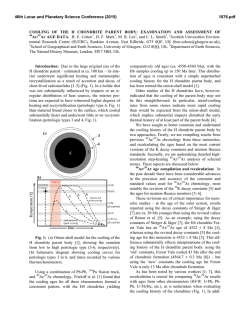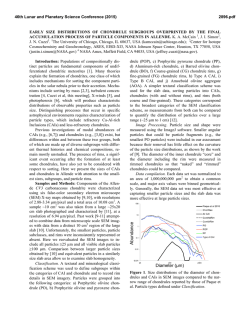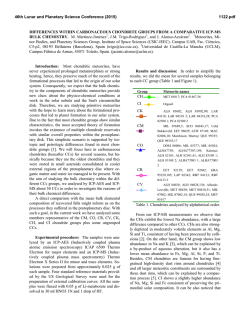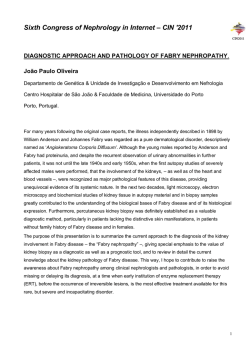
Major-Element Geochemistry of Large, Igneous
46th Lunar and Planetary Science Conference (2015) 1572.pdf MAJOR-ELEMENT GEOCHEMISTRY OF LARGE, IGNEOUS-TEXTURED INCLUSIONS IN ORDINARY CHONDRITES. K. Armstrong1 and A.M. Ruzicka1, 1Portland State University Department of Geology (17 Cramer Hall, 1721 SW Broadway, Portland, OR, USA). Introduction: Approximately 4% of O chondrites contain large inclusions of igneous-textured material [1]. These inclusions are about an order of magnitude larger than most chondrules in O chondrites and are almost always highly depleted in metal and sulfide relative to their host meteorite [2-7]. They are otherwise diverse, suggesting various formation mechanisms [3,4]. Proposed models include shock melting with an associated loss of metal and sulfide [e.g., 3,4,8-10]; melting of vapor-fractionated condensate mixtures [3,4]; large chondrules [3-5,11]; and igneous differentiation [2,12,13]. This work details the petrography and major element bulk chemistry of 29 of these inclusions from a diverse array of host meteorites. These data indicate that (I) none of the inclusions in this study were derived from an igneous-differentiation source; (II) the inclusions can be subdivided into three chemical groups: unfractionated, vapor fractionated, and feldspar enriched; (III) a subgroup of inclusions likely crystallized as free-floating droplets in a space environment, and these were often vapor fractionated; and (IV) some inclusions that probably derive from shock-melted material have a pronounced K enrichment (fig. 1). Methods and Materials: Petrographic analyses of 29 inclusions from 23 meteorites in polished thin section were conducted with optical light microscopy (OLM) and scanning electron microscopy (SEM). Backscattered electron micrographs and false-color chemical phase maps were obtained for each inclusion in order to provide additional petrographic data and determine modal abundance. Major phase compositions were obtained with the SEM using a silicon-drift energy dispersive X-ray (EDX) detector integrated with an Oxford Instruments AZtec X-ray analytical system. Some of these data were then verified with electron microprobe analyses (EMPA). Bulk chemistry was then determined via modal reconstruction. Results: The inclusions show variations in texture and mineralogy but all are dominated by olivine and/or low-Ca pyroxene. Bulk chemistry for most inclusions is essentially chondritic, less metal and sulfide; the inclusions all cluster around average O-chondrite composition when projected on a normative olivineplagioclas-quartz (Ol-Pl-Qz) ternary. Even so, the inclusions can be separated into three chemical groups that probably have different origins. Figure 1: (A) The unfractionated inclusions are essentially chondritic; (B) comparison of unfractionated inclusions enriched in K compared to known impact melt; (C) the vapor-fractionated inclusions have a clear trend of increasing depletion with increasing volatility. Errors are standard deviations. Average O chondrite data from [14]. Discussion and Conclusions: There is no correlation between host meteorite type and any inclusion property. Trends in bulk chemistry. Broadly, the lithophileelement chemistry of the inclusions can be described as either unfractionated, vapor fractionated, or enriched in feldspar. The major element compositions 46th Lunar and Planetary Science Conference (2015) of vapor-fractionated inclusions have a clear tendency to be depleted in more volatile elements, whereas unfractionated inclusions are, on average, very close to average O chondrite. Four inclusions are enriched in feldspar (fig 1), and a fifth is depleted. A feldsparenrichment (fig 2) is what one would expect based on observations of melt pockets and shock experiments that suggest preferential melting of feldspar. Figure 2: Al-normalized Na+K vs Si for all inclusions. The vapor fractionated inclusions tend to have a distinctly lower (Na+K)/Al ratio than the unfractionated inclusions, as a result of losing the more volatile Na and K. The lone exception, Par-I2, an inclusion from Parnallee, also lost Al, possibly though fractional condensation. The feldspar enriched inclusions are enriched in both the alkalis and Al. A mixing line of Ab85An15 and average O chondrite is shown; the feldspar-enriched inclusions are in good agreement with this line. Crossed symbols are droplets. Timing of Melting. Some inclusions were metamorphically equilibrated before becoming incorporated into their host, and some hosts were equilibrated before inclusions were added. This indicates that molten material in the early solar system formed both before and after metamorphic heating. Igneous Differentiation. Calculated normative compositions projected onto an Ol-Pl-Qz ternary diagram plot close to the average O chondrite composition. Inclusions do not plot near cotectics or reaction curves. This implies that none of the inclusions in this study derive from a differentiated source. Drop-formed inclusions. Eight inclusions have compelling evidence that they, like chondrules, crystallized as free-floating droplets in space. These inclusions are round in shape, have textures commonly seen in chondrules, concentric textures, radial variations in texture and/or chemistry, and appear to have interacted with their surroundings. Many of them 1572.pdf have a texturally distinct rim or mantle, also a common feature of chondrules. Interestingly, all nine of these inclusions may have been affected by a volatility fractionation process (fig 2). These inclusions, as a group, thus potentially formed as melt droplets that experienced a kinetic process, such as condensation or evaporative heating. Shock melt. There is compelling evidence that at least one, and probably several, of the inclusions in this study are shock melts. 869-I1 is contained in a host meteorite, NWA 869, that is relatively well studied [e.g., 15]. The CML sample studied here has numerous shock-darkened regions, and the inclusion itself appears to have intruded into and partially melted the host. The inclusion also resembles, in texture and in olivine chemistry, clasts in other samples of NWA 869 that others have identified as impact melt rocks [15]. Two inclusions, including 869-I1, have essentially chondritic bulk chemistries but are enriched in K, in some cases to a striking degree (fig 1B). The apparent excess of K, without an excess of Na, suggests that metasomatism is not responsible for the K enrichment. Analyses of other samples known to be shock-melt have also shown an excess of K, suggesting that Kenrichment may be an indicator of shock (fig 1B). References: [1] Bridges J.C. and Hutchison R. (1997) Meteoritics & Planet. Sci., 32(3), 389–394 [2] Ruzicka A.M. et al. (1995) Meteoritics, 30(1), 57–70 [3] Ruzicka A.M. et al. (1998) Geochim. et Cosmochim. Acta, 62(8), 1419–1442 [4] Ruzicka A.M. et al. (2000) Antarctic Met. Res., 13, 19–38 [5] Binns R.A. (1967) Mineral. Magazine, 36(279), 319–324 [6] Prinz M. et al. (1988) Meteoritics, 23, 297 [7] Hutchison R. (2004) Cambridge University Press [8] Dodd R.T. and Jarosewich E. (1976) Earth and Planet. Sci. Lett., 44(2), 335–340 [9] Fodor R.V. and Keil K. (1976) Geochim. et Cosmochim. Acta, 40(2), 177–189 [10] Jamsja N. and Ruzicka A.M. (2010) Meteoritics & Planet. Sci., 45(5), 828–849 [11] Weisberg M.K. et al. (1988) Meteoritics, 23, 309 [12] Hutchison R. et al. (1988) Earth and Planet. Sci. Lett., 90(2), 105–118 [13] Ruzicka A.M. et al. (2012) Meteoritics & Planet. Sci., 47(11), 1809–1829 [14] Jarosewich E. (1990) Meteoritics, 25, 323-337. [15] Metzler K. et al. (2011) Meteoritics & Planet. Sci., 46(5), 652-680.
© Copyright 2026
